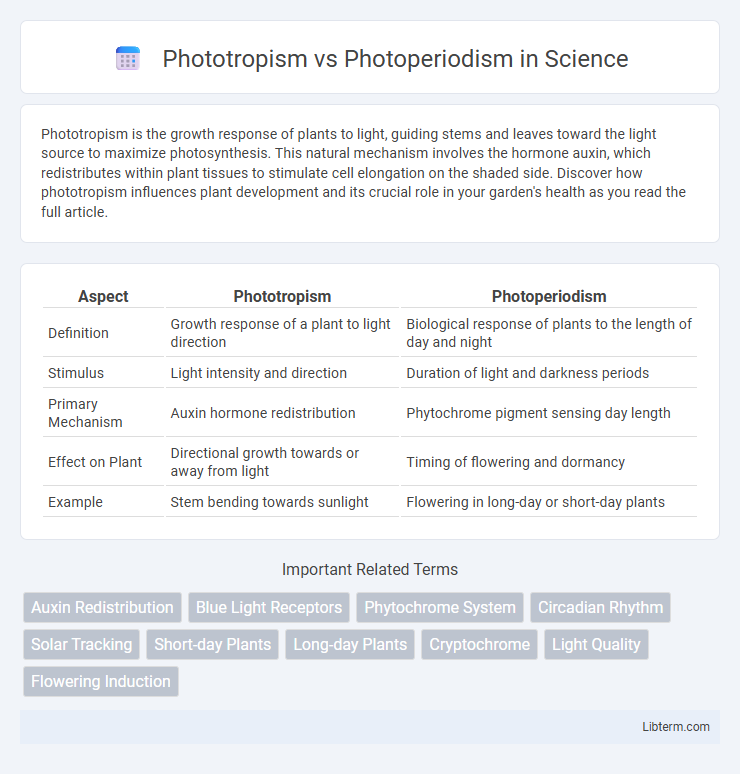Phototropism is the growth response of plants to light, guiding stems and leaves toward the light source to maximize photosynthesis. This natural mechanism involves the hormone auxin, which redistributes within plant tissues to stimulate cell elongation on the shaded side. Discover how phototropism influences plant development and its crucial role in your garden's health as you read the full article.
Table of Comparison
| Aspect | Phototropism | Photoperiodism |
|---|---|---|
| Definition | Growth response of a plant to light direction | Biological response of plants to the length of day and night |
| Stimulus | Light intensity and direction | Duration of light and darkness periods |
| Primary Mechanism | Auxin hormone redistribution | Phytochrome pigment sensing day length |
| Effect on Plant | Directional growth towards or away from light | Timing of flowering and dormancy |
| Example | Stem bending towards sunlight | Flowering in long-day or short-day plants |
Introduction to Phototropism and Photoperiodism
Phototropism is the growth response of plants directed by light, where stems exhibit positive phototropism by growing towards light sources, while roots often show negative phototropism by growing away from light. Photoperiodism refers to a plant's physiological reaction to the length of day and night, influencing critical processes such as flowering and dormancy. Both phenomena are essential for plant adaptation and survival, regulated by specific photoreceptors like phytochromes and cryptochromes.
Defining Phototropism: Mechanisms and Functions
Phototropism is the growth response of plants toward or away from light, primarily regulated by the hormone auxin, which redistributes to the shaded side, causing cell elongation and bending of plant organs like stems and leaves. This directional growth enhances photosynthesis by optimizing light capture and supports survival by enabling plants to adjust to their light environment dynamically. Phototropism differs from photoperiodism, which involves plant developmental responses based on the duration of light and dark periods rather than light direction.
Understanding Photoperiodism: Biological Importance
Photoperiodism is the biological response of organisms to the length of day and night, regulating critical processes such as flowering, dormancy, and migration in plants and animals. It controls seasonal behaviors by detecting changes in light duration through photoreceptors like phytochromes, enabling plants to synchronize growth and reproduction with environmental cues. Understanding photoperiodism is essential for optimizing agricultural practices and managing crop cycles to improve yield and stress resilience.
Key Differences Between Phototropism and Photoperiodism
Phototropism refers to a plant's directional growth response towards or away from light, primarily driven by auxin hormone distribution, influencing stem and root orientation. Photoperiodism is a plant's physiological reaction to the length of day and night, regulating flowering and seasonal activities based on light duration. The key differences lie in phototropism's focus on growth direction in response to immediate light stimuli, while photoperiodism controls developmental processes tied to the timing of light exposure over days.
Hormonal Regulation in Phototropism and Photoperiodism
Phototropism is primarily regulated by the plant hormone auxin, which accumulates on the shaded side of a stem, causing cells to elongate and the plant to bend toward light. In photoperiodism, hormonal regulation involves phytochrome-mediated changes that influence levels of florigen and gibberellins, triggering flowering in response to day length. Both processes integrate hormonal signals to adapt growth and development to environmental light cues essential for plant survival.
Environmental Factors Affecting Both Responses
Phototropism and photoperiodism are influenced by environmental factors such as light intensity, wavelength, and duration. Phototropism depends on light direction and intensity to guide plant growth toward or away from light sources, primarily involving auxin distribution. Photoperiodism relies on the length of day and night to regulate flowering and other developmental processes through phytochrome-mediated signaling pathways.
Examples of Phototropism in Plants
Phototropism is the growth of plants in response to light direction, seen in examples like sunflower stems bending toward sunlight and bean seedlings elongating their shoots toward light sources. In contrast, photoperiodism involves plants responding to the length of day and night to regulate flowering, as seen in short-day plants like chrysanthemums and long-day plants like spinach. Phototropism primarily affects plant orientation and growth patterns, while photoperiodism controls developmental cycles based on light duration.
Examples of Photoperiodism in Plants
Photoperiodism in plants is demonstrated by the flowering behavior of species such as short-day plants like chrysanthemums and long-day plants such as spinach, which rely on the length of night to trigger blooming. Soybeans and poinsettias exhibit intermediate-day photoperiodism, where flowering depends on the night length being between certain critical durations. These plant responses regulate crucial agricultural and horticultural practices by adjusting growth cycles to seasonal light changes.
Agricultural Impacts of Phototropism vs Photoperiodism
Phototropism influences crop orientation by directing plant growth toward light sources, optimizing photosynthesis and improving yield efficiency. Photoperiodism regulates flowering times and developmental stages based on day length, crucial for scheduling planting and harvesting cycles to maximize productivity. Understanding both mechanisms enables agricultural management practices that enhance crop adaptation to environmental conditions and optimize growth outcomes.
Future Research and Applications in Plant Science
Emerging research in phototropism explores the molecular mechanisms underlying directional growth responses to light, promising advanced crop engineering for optimized light capture and yield. Studies on photoperiodism aim to manipulate flowering times through gene editing of circadian rhythm components, enhancing agricultural productivity and climate adaptability. Integrating insights from both phototropism and photoperiodism could revolutionize precision agriculture by enabling plants to better synchronize growth and reproductive cycles with changing environmental light conditions.
Phototropism Infographic

 libterm.com
libterm.com